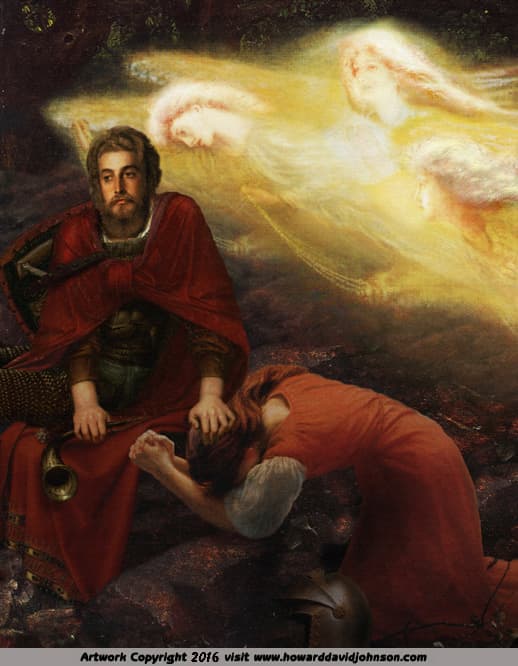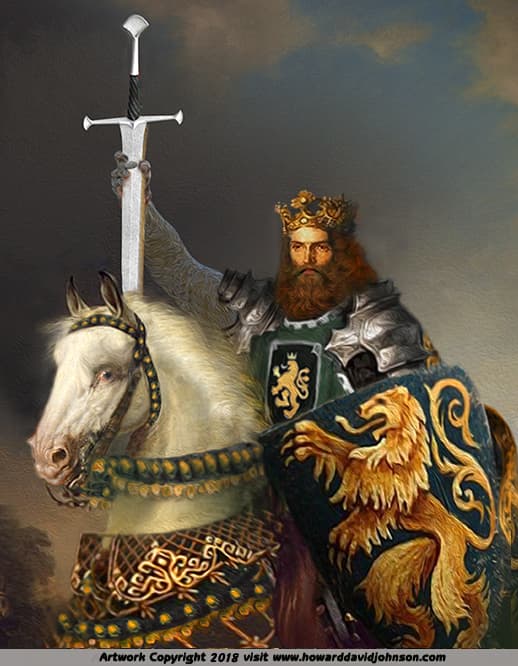Former and Future King: How Tennyson Recenters King Arthur
by Samantha Costa
After finishing Idylls of the King, it’s clear through Tennyson’s reverent rendition of the Arthurian tales just how much respect and admiration he has for his source material, Le Morte D’Arthur by Sir Thomas Malory. However, the collection’s final poems “Guinevere” and “The Passing of Arthur” illustrate that, despite his appreciation for Malory’s work, Tennyson is willing to alter the Arthurian legends to adhere to his own values and the values of the Victorian world.
In the Idylls, Tennyson recenters King Arthur as the main tragic figure of the Arthurian legends by openly denouncing Guinevere’s actions, removing Lancelot from the spotlight, and reshaping Arthur’s character to fit Victorian values.
Guinevere Defeated

In “Guinevere,” I was shocked by just how much moral criticism Guinevere received about her adultery. Though she was almost burned at the stake in Malory, the “good guy” characters all pretty much agreed that it was just for appearances. However, Tennyson’s choice makes sense for a Victorian audience that would reproach adultery in a way that a medieval audience that knew the dynamics of courtly love would not. I think that this Victorian moral criticism of adultery helps Tennyson achieve his ends of uplifting Arthur as a supremely honorable figure that has been consistently wrongfully betrayed by everyone around him. Guinevere is no longer, then, afforded the excuse of love in her disloyalty– she is deemed just as bad, if not worse, than all of the other knights who have defamed the Round Table.
Where’s Lancelot?
Lancelot is my favorite character, so imagine my disappointment when Tennyson wrote about him so little! Especially in the last poems of Idylls of the King, Lancelot’s defense of his honor and attempt to remain loyal to Arthur even while warring against him are notably absent. Even though I liked Lancelot’s constant battle to maintain his worship in Le Morte D’Arthur, I think that it’s harder to focus our sympathies and admiration on Arthur when Lancelot is being so sympathetic. In order to recenter Arthur as the scorned hero of the narrative, the only alternative would be to make Lancelot evil or, at least, Tristram-like in vanity and arrogance– which would be completely disingenuous to his character. Therefore, our favorite hero had to take a backseat in Tennyson’s poems to let King Arthur hold the final spotlight.
Reshaping Arthur
Just as the Victorians don’t have the same opinions on love as the Arthurians, they also don’t have the same viewpoint on kings. In a time where the people of England were getting more representation, the monarch did not have the same automatic reverence that a medieval King would have received from his people. Instead, they had to work for it, proving themselves to be worthy of the power that they commanded. In this context, Tennyson’s Arthur had to be built up with Victorian morals to better emphasize the gravity of his downfall. In Tennyson’s version, the revelation of Guinevere’s adultery is not downplayed by Arthur already having a “deeming of it.” He blatantly scorns her for her sins. Then, like a good Christian, he forgives her too–– an act that puts him on a Christ-like pedestal. Tennyson removes Arthur’s incest with his sister and instead cleanly makes Mordred just his nephew. For good measure, Arthur even notes that he’s never had intercourse with anyone but Guinevere.

Tennyson makes Arthur an embodiment of purity, honor, and sacrifice. He is the body politic; a physical representation of the perfect glory of Camelot that has been torn down, beaten, and destroyed by betrayal and dishonor.
Conclusion
While the Lancelot fan in me wishes that he had his moment in the final idylls, I think that Tennyson’s version better emphasizes the tragedy of not only Arthur’s death, but the downfall of Camelot. By recentering Arthur in Idylls of the King, Tennyson really effectively portrays the emptiness, loss, and despair that the Victorian world suffers from without the idealized values of the medieval world.
Images “The Angels of Forgiveness” and “King Arthur Close Up” by Howard David Johnson: https://www.howarddavidjohnson.com/arthurian.htm





